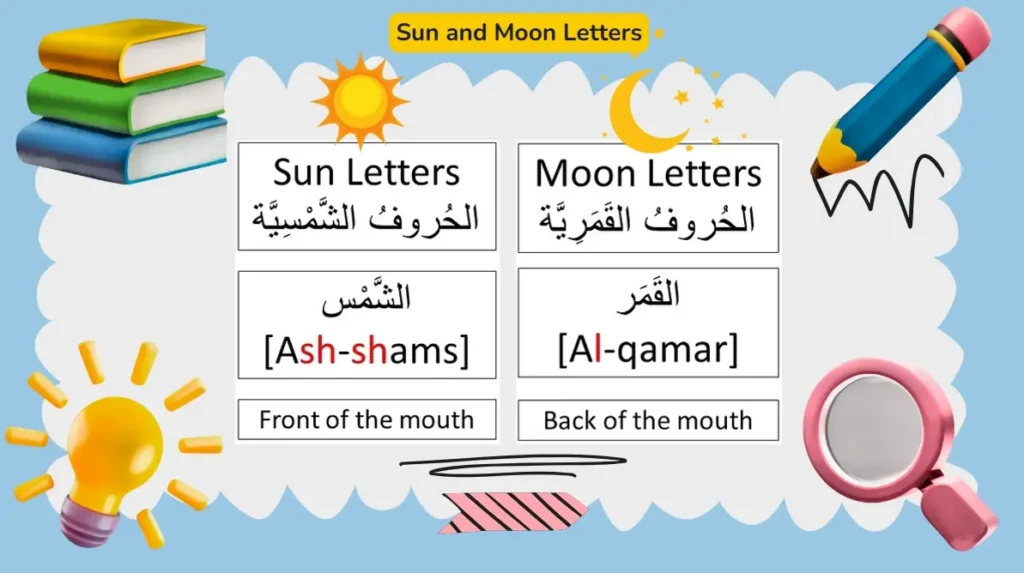Many learners of Modern Standard Arabic struggle with the concept of Sun and Moon letters (الحروف الشمسية والقمرية). Often, the confusion arises because teachers don’t explain it thoroughly, or students learning Arabic independently can’t find a clear explanation.
This post aims to clarify the concept in the simplest way possible, using practical examples. Here’s your guide to differentiating between Sun and Moon letters and applying the phonetic changes they require.
Why Is It Important to Distinguish Sun and Moon Letters?
If you’re learning to speak or read Modern Standard Arabic, understanding the rules around Sun and Moon letters is crucial. Mispronouncing these letters is among the most common mistakes beginners make. While it’s okay to make errors while learning, not addressing this early on can lead to a habit that’s tough to fix.
Even advanced Arabic learners sometimes stumble with Sun letters, though it doesn’t change the word’s meaning. This noticeable mistake could be jarring to a native Arabic speaker’s ears. Since these rules are easy to grasp and apply, there’s no reason not to follow them.
What Are Sun and Moon Letters?
Sun and Moon letters in Arabic affect how the definite article (ال) is pronounced.
- Moon letters (الحروف القمرية) don’t affect the “ل” sound in the definite article. So, the “ل” is always pronounced clearly.
- Sun letters (الحروف الشمسية) make the “ل” before them silent.
The Arabic Definite Article
Arabic has a single definite article, made up of two letters: ال (AL). Any word that follows it will start with ال + [word]. For example: الكتاب (Al-Kitaab) means “The book.”
Why Are They Called “Sun Letters”?
If you take a look at the word for “sun” in Arabic, الشمس (Ash-Shams), you’ll notice it’s pronounced Ash-Shams, not Al-Shams. The “ش” (sh) sound in “الشمس” is a Sun letter, which makes the “ل” in the article ال silent.
Which Ones Are the Sun Letters?
The Sun letters are:
ت، ث، د، ذ، ر، ز، س، ش، ص، ض، ط، ظ، ن، ل.
What About the Moon Letters?
Any letter not listed above is a Moon letter:
أ، ب، ج، ح، خ، ع، غ، ف، ق، ك، م، ه، و، ي.
Why Are They Called “Moon Letters”?
They’re called Moon letters after the word القمر (Al-Qamar), meaning “the moon.” The word القمر starts with the Moon letter “ق.”
When you add the definite article ال to قمر, it becomes القمر (Al-Qamar), with the “ل” pronounced clearly.
How Are Sun Letters Pronounced with the Definite Article?
Here’s how to apply the Sun and Moon letters rule in Arabic:
- Take a word in its indefinite form:
شمسطبلكتاب
- Add the definite article (ال) to each:
Al-Shams(ال + شمس)Al-Tabl(ال + طبل)Al-Kitab(ال + كتاب)
- Identify if the first letter is a Sun letter:
- الشمس: Starts with “ش” (Sun letter). Pronounced
Ash-Shams. - الطبل: Starts with “ط” (Sun letter). Pronounced
At-Tabl. - الكتاب: Starts with “ك” (Moon letter). Pronounced
Al-Kitab.
- الشمس: Starts with “ش” (Sun letter). Pronounced
Final Pronunciations
Notice how the Sun letters “ش” and “ط” in the first two words change the pronunciation:
Ash-Shams(الشمس)At-Tabl(الطبل)Al-Kitab(الكتاب)
Practice the Pronunciation
Practice words that start with Sun letters to master this concept. After a few days of practice, it’ll come naturally.
Arab vs Arabian vs Arabic: What’s the Difference?
Mastering the rules around Sun and Moon letters will dramatically improve your Arabic pronunciation. With a bit of practice, you’ll be using them naturally in no time! Check out [Arabic Essential Grammar for English Speakers] for more great tips on Arabic grammar.
Here’s a quick reference table:
Sun Letters Table
| Sun Letters | Example Words |
|---|---|
| ت | التاجر (At-Tajir) – The merchant |
| ث | الثورة (Ath-Thawra) – The revolution |
| د | الدار (Ad-Daar) – The house |
| ذ | الذئب (Adh-Dhi'b) – The wolf |
| ر | الرجل (Ar-Rajul) – The man |
| ز | الزرافة (Az-Zaraafa) – The giraffe |
| س | السرير (As-Sareer) – The bed |
| ش | الشجرة (Ash-Shajara) – The tree |
| ص | الصديق (As-Sadeeq) – The friend |
| ض | الضابط (Ad-Daabit) – The officer |
| ط | الطالب (At-Taalib) – The student |
| ظ | الظل (Az-Zill) – The shade |
| ن | النهر (An-Nahr) – The river |
| ل | الليل (Al-Layl) – The night |
Moon Letters Table
| Moon Letters | Example Words |
|---|---|
| أ | الأسرة (Al-Usra) – The family |
| ب | الباب (Al-Baab) – The door |
| ج | الجمل (Al-Jamal) – The camel |
| ح | الحديقة (Al-Hadeeqa) – The garden |
| خ | الخروف (Al-Kharoof) – The lamb |
| ع | العصفور (Al-Asfoor) – The bird |
| غ | الغرفة (Al-Ghurfa) – The room |
| ف | الفلاح (Al-Fallaaḥ) – The farmer |
| ق | القمر (Al-Qamar) – The moon |
| ك | الكتاب (Al-Kitaab) – The book |
| م | المسجد (Al-Masjid) – The mosque |
| ه | الهواء (Al-Hawaa) – The air |
| و | الوردة (Al-Warda) – The rose |
| ي | اليد (Al-Yad) – The hand |
FAQs About Sun and Moon Letters
Sun and Moon letters refer to how specific letters affect the pronunciation of the Arabic definite article ال. Sun letters make the “ل” sound silent, while Moon letters do not affect it.
Try memorizing the list of Sun letters first since there are only 14. If a letter doesn’t belong to this group, it’s a Moon letter by default. Repetition and practice will help reinforce this.
Phonetic convenience. The Sun letter following the article “absorbs” the “ل” to create a more seamless pronunciation by doubling the Sun letter as a sound. For example, “الشمس” (Ash-Shams) instead of “Al-Shams”.
▶️ Índice:


